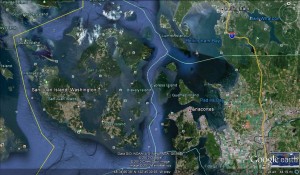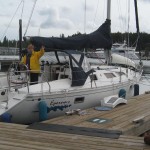- San Juan Islands, Washington
It was a most enjoyable sailing adventure.
“Septuagenarians’ San Juan Sail”
BY STEVE COLEMAN
Steve Coleman, with chart, and Dr. Carden Johnston sailed the San Juan Islands with their wives and demonstrated that voyaging is feasible for sailors in their 70s.
Steve Coleman
To the editor: This May my wife, Sumter, and I enthusiastically jumped at the invitation to sail in the San Juan Islands of Washington State. Our close friend, Dr. Carden Johnston, recently joined a sailing club in Seattle and wanted us along with him and his wife, Suzie, to tour the islands aboard a 36-foot Jeanneau sloop. Although he is not greatly experienced in sailing larger boats, he’s a great athletic outdoorsman. I’m not so athletic anymore, but I hold a USCG Master’s license.
With all of us being in our 70s, there may have been some question as to whether we should undertake the adventure, especially since both Suzie and Sumter had joint surgery within the last year. But they accepted the challenge. We would have to sail smarter, plan better and be more cautious than younger folks. My belief was that knowledge, skill and experience would make up for our advanced age and other infirmities.
I spent several hours studying the nautical chart, laying out our routes, picking waypoints, recording lat/longs, courses, distances, and also reading the cruising guide. My experience as a naval navigator and instrument-rated private pilot has proven to me how vital planning is, especially when going into unfamiliar territory. I plotted our daily sails to be about 20 miles each.
At noon on May 26, we met at Cap Sante Marine in Anacortes, Wash., and boarded the handsome but unfamiliar sloop, Epernay.
The first thing I discovered was that the GPS unit, into which I expected to put all my pre-planned waypoints and courses, was an older version which lacked much of the up-to-date technology. We downloaded an app from Navionics for iPhones and got underway. At the helm, I discovered that turning the boat around in the space between docks was not practical because the wind was blowing the bow away too fast, so I backed 100 yards or so and negotiated a turn out of the narrow channel.
On the first day, the wind abruptly died. As we motored into Rosario Strait, light rain and fog closed in from the west, obscuring our view of the islands three miles away. When the cliffs of Blakely Island finally loomed out of the mist, we consulted the iPhone GPS and realized that the current had set us north of Thatcher Pass. Using up some of the dwindling battery charge on Carden’s phone we checked our position, and then turned it off. Having lost about 20 minutes by misdirection, we finally entered the narrow pass and were able to navigate visually from there on. We hadn’t brought a 24-volt charger and wouldn’t have 110 volts until docking again.
The fog lifted as we motored toward Eastsound on Orcas Island. Up came a little wind, and the spry and agile Carden volunteered to climb up to the mast to raise the mainsail.
Despite our late departure, wind and current put us just outside Rosario well before sunset. But before we could enter we had to deal with a mainsail that wouldn’t come down, despite Carden’s efforts to pull down on the luff. Suzie was in the cockpit, so I asked her to take the helm and hold us in the wind — something entirely new to her. I went to the aft end of the boom, grabbed the leech of the sail and tugged, while Carden tugged at the luff. Meanwhile Suzie struggled, trying to remain headed up, so that the sail filled on one side and then the other. I coached her on steering while Carden and I actually hung our combined weight on the sail. When Suzie got us headed up again, the sail freed and dropped. It was one of those problems that seems minor, once you fix it, but how major it can be if you can’t.
The second night’s stopover was Roche Harbor with its large, busy marina. The next morning, we decided to leave via Mosquito Pass, a narrow little passage that winds treacherously between rocky shoals as the ebb currents swirl toward Haro Strait. There we found a dozen seals sunning themselves on the rocks, apparently awaiting the tide to slack. Once in the strait, we turned south, and sailed with 15-knot winds. A gust hit us while tacking. The windward jib sheet got free and flew across the deck and into the water, causing a momentary bit of excitement and confusion. Calmly problem-solving, we furled the sail, thereby taming the wildly whipping jib sheet. It was a minor incident, but it provided an example of how using one’s head instead of one’s physical prowess is vital, especially for an older, less agile crew.
Sailing skill is a combination of both physical and mental capabilities. No matter your age, you should rely more on your brain than your brawn. In spite of all, sailing in open and windy Haro Strait was the most fun for all of us. We came down the western side of San Juan Island, through the narrow passage at its southern tip and back up to Friday Harbor on the eastern side. Tourists arrived by ferry or seaplane, but we counted ourselves among the better adventurers for having sailed there on our own.
On the morning of our final day, under sunny morning skies we motored out, waved to the passengers on the arriving ferry, and headed for Anacortes. We hoped for wind, but even had to motor across Rosario Strait into Guemes Channel in a flat calm with opposing current. It was afternoon before we rounded Cap Sante and entered the marina.
At the helm, I noted the wind was off our port bow, at about 10 knots as I negotiated the narrow channel between docks, headed for our berth. Playing the wind, I intentionally backed in the slip alongside another boat to windward, coming within about a foot of it. The boat owner came topside, concerned about our close approach. Carden, too, hurried to the port side to fend us off, though I tried to assure them that the wind was going to blow us away and over to our berth to starboard. Although the boat’s drift was as I expected, Carden, misunderstanding my maneuver and wanting to help, ran to the starboard side, spring line in hand, and leapt four feet across, landing heavily on the floating dock below. It recoiled from the force, throwing him down and then rolling him over into the water! But with the strength of someone half his age and adrenalin flowing, he quickly pulled himself out.
We tied up, and Carden, forever a good sport in all things, posed as I took his picture while he smiled and wrung out his shirt. He was not too shaken up, but his iPhone was drenched beyond repair, thankfully the only casualty during our otherwise pleasant adventure. Upon reflection, I recognized my failure was in not verbally explaining my maneuver as I made the approach to the dock. Had I done so, Carden would have understood that I had the situation under control and would not have felt the need to make the risky jump.
——————
Steve Coleman’s first novel, The Navigator: A Perilous Passage, Evasion at Sea is available at www.amazon.com/dp/0985006501 and is also available for Amazon Kindle. His website is www.captstevestories.com.
Add your comment:





